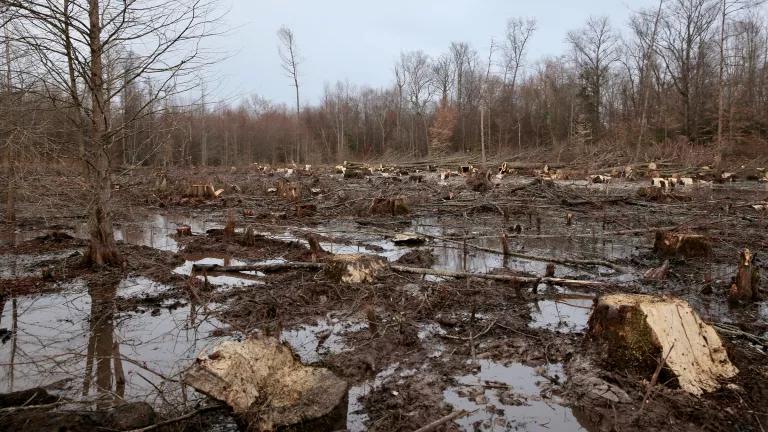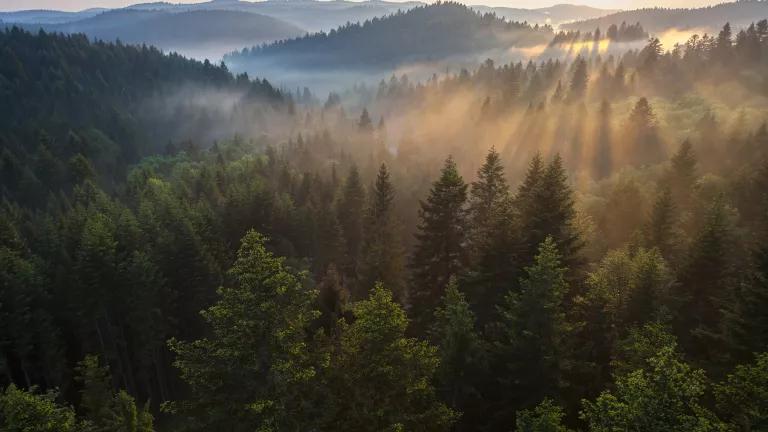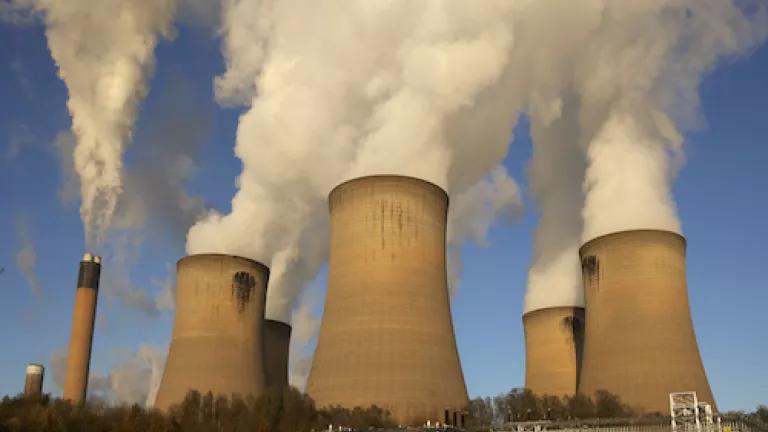UK Plans to Increase Biomass Energy Are SUPER Risky
The UK government should immediately end billions in subsidies for large biomass power plants and reinvesting the savings in wind, solar, and other real climate solutions.

Logging to produce wood pellets for biomass energy conducted by Pinnacle/Drax near Burns Lake, British Columbia
The UK Government’s recent Net Zero Strategy makes clear that bioenergy, and BECCS (bioenergy with carbon capture and storage), is central to its climate plan.
Unfortunately, in doing so, the Government risks putting the cart before the horse, creating a large new market for BECCS without adequately considering the land use implications. Indeed, the new Strategy fails to fully address the amount of land that large-scale reliance on BECCS will require—and whether this is sustainable or even realistic.
The short answer: it’s not. Whether the UK continues to burn millions of tonnes of imported trees from global forests as fuel for BECCS power stations, massively expands domestic production of energy crops, or some combination of both, expanding bioenergy use will require amounts of land that are high risk for people and planet.
Currently, the UK—the top importer of biomass in the world (and the top subsidizer of biomass too)—relies overwhelmingly on wood pellet imports to fuel its biomass power stations. But to increase biomass to the scale it anticipates in its new plan, it says it will also start growing bioenergy crops domestically.
This is a red herring. Providing all the material for BECCS using home-grown energy crops could require using one quarter of all land in the UK. And, based on UK Climate Change Committee (CCC) projections, to meet bioenergy demand, energy crops will need to be planted on up to 1.4 million hectares of the UK’s land by 2050—about 6% of all land in the UK!
Taking up this amount of land with crops for biomass energy is risky on several fronts.
First, increasing the proportion of biomass burned in the UK from domestic crops would carry risks for the UK in terms food production.
Second, significantly increasing domestic biomass production would interfere with many of the promises the UK has made regarding nature, which are critical given that 15% of UK species are at risk of national extinction and 41% are declining in number—not to mention that scientists predict the planet will lose 1 million species. The UK Government has promised to increase space for nature domestically, even setting a target to protect 30% its land by 2030 as part of the international “30 by 30” initiative. Given that Wildlife and Countryside Link found that only 3% of England’s land is currently protected for nature and in good condition, the country has a long way to go to meet these goals. And using more of the UK’s land for energy crops would prevent the country from fulfilling these commitments.
Finally, wood-burning power stations like the UK’s Drax are not set up to support alternative feedstocks like many of the ones that would be planted in the UK instead of the wood pellets they currently burn. Widespread use of UK energy crops would require expensive equipment upgrades, such as new boiler systems. That’s probably why Drax has invested hundreds of millions in wood pellet plants in the U.S., Canada, and other countries, making Drax not only the world’s largest tree-burning power station, but also the world’s second largest wood pellet company. It’s also probably why the UK hasn’t been able to expand biomass bioenergy supply in the past, despite its intention to do so. For example, the UK’s 2012 Bioenergy Strategy predicted that it would be able to rely on 90-150 Terawatt hours (TWh) of domestic biomass supply by 2020, but by 2018 only 1% of the biomass used for energy in the UK came from domestically-grown crops.
So if the UK can’t produce more bioenergy feedstock domestically, where will it get enough material to meet increased bioenergy production?
The only alternative to growing it themselves is to import even more wood pellets from overseas, meaning more tree-burning and more harm to global forests.
Increasing the UK’s biomass production to the extent envisioned in its new strategy with imports alone could mean more than a doubling current import levels. And import levels are already high with wood pellets from forests in the U.S. Southeast, Canada, the Baltics, and elsewhere making up 99% of the biomass burned at Drax, based on the company’s own reporting.
In the countries from which Drax imports wood pellets, wood for biomass is routinely taken from clearcut forests—including old, climate-critical forests and biodiversity hotspots, stymieing global—and UK goals—to slow climate change and biodiversity loss. Over half of all the biomass Drax burns is from whole trees, despite industry claims that it only burns the “wastes and residues” of logging like branches and stumps. And these trees are often coming from particularly unique forests including Canada’s boreal, nature reserves in the Baltics, and the North American Coastal Plain Biodiversity Hotspot.
What’s more, UK biomass reliance is harming underserved communities in the U.S. southeast, where many of the wood pellet mills are located, polluting their air and robbing them of the surrounding forests, which provide many benefits including acting protection from increasingly frequent storms.
The people and forests where trees are being cut for wood pellets simply can’t take a doubling in wood pellet production.
The bottom line is the UK’s plan to tackle climate change by relying even more heavily on biomass won’t work. On a crowded island, with multiple pressures on land (e.g., food, housing, nature), growing energy crops on a high proportion of the land is a high-risk gambit. And the alternative—increased logging of overseas forests to burn for energy while pretending to be a nature champion—is no better.
Instead, the UK government should immediately end billions in subsidies for large biomass power plants and reinvesting the savings in wind, solar and other real climate solutions. It must also avoid approving large new subsidies for BECCS at Drax, which only risk more tree-burning and would further worsen our climate and nature crises.
The share of UK land required by different land use types*
| UK land use (2050) | % of UK land required by different uses** |
| Energy crops (with ongoing imports) |
6 |
| Energy crops (with no imports, to meet 2050 BECCS demand)*** |
24 |
| Space well-managed, protected, and in good condition for nature**** |
30 |
| Tree cover |
17 |
| Farmland (CCC assumes that improved farming efficiency can release around 25% of current farmland for other uses) |
58 |
* Source for figures: Climate Change Committee
** This comes to more than 100% of UK land because some of these land uses may overlap with each other
*** Chatham House analysis on 2050 BECCS demand and meeting all of this using UK-grown wheat straw




